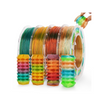3D printing is a popular technology that allows users to create three-dimensional objects through digital modeling. However, nozzle clogging is a common problem that can occur during the printing process. In this article, we will discuss the different causes of nozzle clogging and how to prevent it.
Causes of Nozzle Clogging:
1. Poor quality filament: Low-quality filament can contain impurities, which can cause the nozzle to clog.
2. Dust and debris: Dust and debris can accumulate in the nozzle and cause clogs.
3. Incorrect temperature settings: If the temperature is too low, the filament may not melt properly and cause clogs. If the temperature is too high, the filament may degrade and cause clogs.
4. Incorrect printer calibration: If the printer is not properly calibrated, the nozzle may be too close to the print bed, causing the filament to clog the nozzle.

Solutions to Prevent Nozzle Clogging:
1. Use high-quality filament: Using high-quality filament can reduce the risk of nozzle clogging. High-quality filament has fewer impurities and is more consistent in diameter.
2. Keep the nozzle clean: Regularly cleaning the nozzle can prevent dust and debris from accumulating and causing clogs. Use a small wire brush or a specialized cleaning filament to clean the nozzle.
3. Check temperature settings: Make sure that the temperature settings are appropriate for the filament being used. If the temperature is too low, increase it slightly. If the temperature is too high, reduce it slightly.
4. Calibrate the printer: Make sure that the printer is properly calibrated before printing. Adjust the nozzle height and level the print bed to prevent the filament from clogging the nozzle.
In conclusion, nozzle clogging is a common problem in 3D printing, but it can be prevented by using high-quality filament, keeping the nozzle clean, checking temperature settings, and calibrating the printer. By following these simple steps, users can achieve better printing results and reduce the risk of nozzle clogging.































